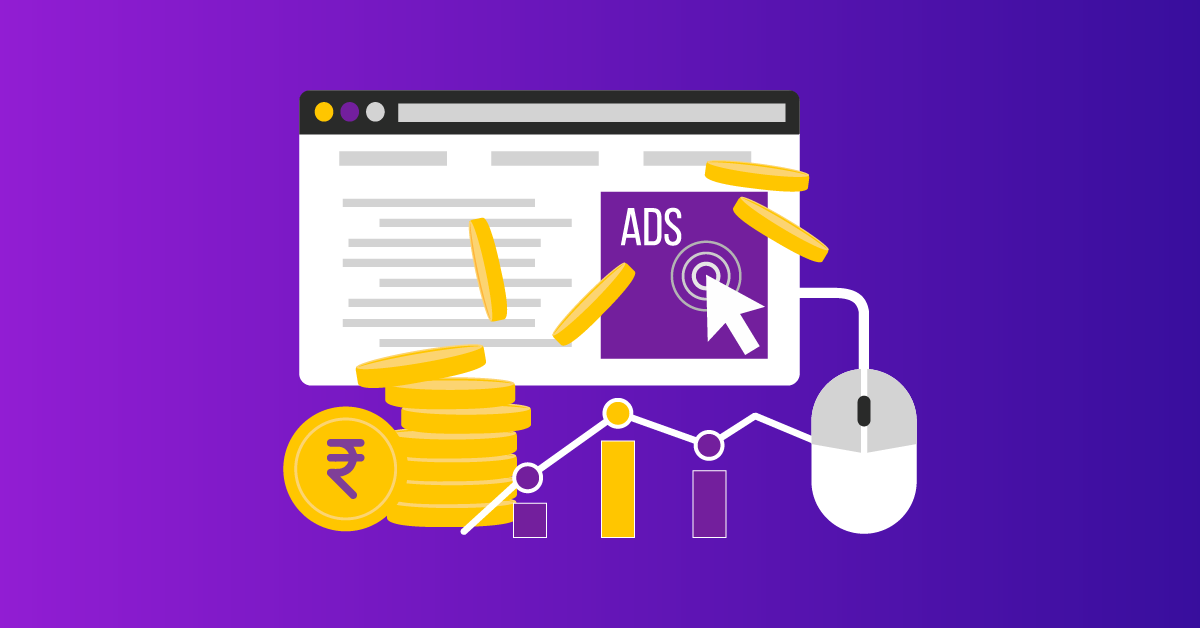What is the Click-through Rate (CTR)? How to Calculate it?
Click-through rate (CTR) is a pivotal metric in the ad tech industry. Esteemed by search engines and integral to the Pay-Per-Click (PPC) model, CTR quantifies the success of engaging users and converting impressions into clicks. But as marketers and advertisers strive relentlessly to maximize CTR, questions linger: Is a high CTR truly the ultimate goal? Does it always lead to success, or are there hidden intricacies to be unraveled?
In this blog, we dissect the interplay between CTR, conversions, and the intricacies of advertising success. Let’s explore the nuanced landscape where conversion rates and return on investment intertwine.
What is CTR?
At its core, CTR is a metric that measures the ratio of clicks an advertisement or link receives to the number of times it’s shown. It serves as a barometer of how effectively an ad engages its audience, translating impressions into tangible interactions.
Click-through rate finds its natural home within the Pay-Per-Click model – a cornerstone of digital advertising. In this model, advertisers pay a fee each time their ad is clicked, making CTR an essential component in assessing the cost-effectiveness of their campaigns. As a common metric flowing through the veins of the advertising industry, CTR stands as a unifying language spoken by marketers, advertisers, and search engines alike.
How to calculate CTR?
The formula for CTR:
CTR is calculated by dividing the number of clicks an ad receives by the number of times the ad is shown (impressions), then multiplying by 100 to express it as a percentage.
CTR = (Clicks / Impressions) * 100
Here’s an example of how to calculate CTR
Let’s say you run an online ad campaign for a new product. Your ad is shown to 10,000 people, and it receives 500 clicks.
Clicks = 500 Impressions = 10,000
Using the formula: CTR = (500 / 10,000) * 100 = 5%
In this example, your ad’s Click-Through Rate (CTR) is 5%. This means that for every 100 people who saw your ad, 5 of them clicked on it.
Who uses CTR and why?
Click-Through Rate (CTR) is a key metric that finds significance among various players in the digital advertising arena. Primarily, advertisers, marketers, and search engines are the main stakeholders who rely on CTR to gauge the effectiveness of their efforts.
Advertisers and Marketers
Advertisers and marketers closely monitor CTR to assess how engaging their ads are to users. A higher CTR typically suggests that the ad is catching the attention of its audience and encouraging them to take action, such as clicking on the ad to learn more. By tracking CTR, advertisers can identify which ads are resonating with their target audience and refine their strategies accordingly.
Search Engines
Search engines like Google also utilize CTR to determine the relevance and quality of ads and search results. A higher CTR indicates that the displayed content is aligning well with user intent, leading to better user satisfaction. Search engines use CTR as a signal to assess the performance of ads and the quality of the content they display.
Who should use CTR?
Any individual or organization engaged in online advertising should pay attention to CTR. This includes businesses of all sizes, marketers, advertisers, e-commerce platforms, service providers, and even content creators. Essentially, anyone looking to drive traffic, conversions, and engagement through online ads can benefit from tracking and analyzing CTR.
Calculating CTR helps you understand how effective your ad is in generating interest and engagement among the audience. A higher CTR typically indicates that your ad is resonating well with viewers, while a lower CTR might suggest that the ad needs optimization or that the targeting needs adjustment to better match the intended audience.
What is a good or strong CTR?
Strong click-through rate (CTR) varies depending on the context, industry, and type of advertising campaign. Generally, a CTR above 2% is often considered decent, while a CTR exceeding 5% can be considered strong.
However, it’s important to note that what constitutes a strong CTR can differ based on factors such as:
- Industry
Different industries have varying levels of competition and user behavior. For example, industries with high competition and sophisticated targeting may have lower average CTRs.
- Type of ad
Display ads, search ads, social media ads, and email campaigns can have different CTR benchmarks due to audience expectations and the platform’s nature.
- Ad placement
Where the ad is placed on a webpage or within an app can influence CTR. Above-the-fold placements often yield higher CTRs.
- Ad format
Rich media ads, video ads, and interactive ads might have higher engagement and therefore different CTR benchmarks.
- Target audience
Understanding your target audience and their preferences is crucial. A well-targeted ad might achieve a higher CTR.
- Campaign goals
If the goal of your campaign is to drive traffic, a higher CTR might be the focus. However, if the goal is conversions or sales, CTR is just one factor to consider.
- Device and platform
CTRs can vary between desktop and mobile devices, as well as across different advertising platforms.
Ultimately, what matters most is the relationship between CTR and your campaign’s objectives. A “strong” CTR is one that aligns with your goals and outperforms industry averages while also delivering valuable engagement and conversions. Always keep in mind that CTR is just one metric among many, and it’s important to evaluate it within the larger context of your advertising strategy and desired outcomes.
Is a ‘high’ CTR good?
While a high Click-Through Rate (CTR) is generally seen as a positive indicator of user engagement, it’s not always a straightforward guarantee of success. In certain situations, an unusually high CTR might raise concerns and warrant further investigation. Here are a few reasons why an exceptionally high CTR could be worrisome:
- Clickfraud
Click fraud can be executed by automated bots, scripts, or even humans who engage in unethical practices. These fraudulent clicks can lead to inflated CTR figures without corresponding actual engagement or conversions. When click fraud occurs, it can result in a sudden and dramatic increase in the number of clicks an ad receives. This, in turn, artificially boosts the CTR.
- Misleading ad content
If your ad promises something in the headline or image that isn’t fulfilled on the landing page, users might click through but quickly exit. This can lead to a high CTR with low conversions, indicating that users aren’t finding what they expected.
In this case, the misleading ad generated a high CTR because the ad successfully piqued users’ curiosity and enticed them to click. However, the subsequent low conversions reveal that users were unable to find what they expected on the landing page, resulting in lost potential customers.
- Unintended placements
If your ad is mistakenly placed on irrelevant websites or platforms, it might attract accidental clicks from users who aren’t genuinely interested in your offer. Moreover, such misaligned placements pose significant brand safety risks, potentially associating a brand with inappropriate, low-quality, or offensive content, eroding consumer trust and damaging reputation.
To mitigate these issues, advertisers must prioritize contextually relevant placements, employ ad verification services, and closely monitor ad performance to ensure that high CTR is not achieved at the expense of brand safety and campaign effectiveness.
- Negative user experience
An ad might have an enticing headline but provide a poor user experience upon clicking. This can result in high bounce rates, indicating that users are quickly leaving your site without taking any meaningful action.
Once users land on the page, their experience should be smooth, intuitive, and user-friendly. Fast loading times, clear navigation, and mobile responsiveness all contribute to a positive user experience.
- Low-quality traffic
High CTR doesn’t always correlate with high-quality traffic. If the audience clicking on your ad doesn’t match your target demographic the high CTR might be misleading. Low-quality traffic refers to website visitors who are less likely to engage with your content, make a purchase, or perform the desired action, and often have a minimal impact on your business goals.
This type of traffic can come from various sources and may not align with your target audience or campaign objectives.
- Frequency
When the same users repeatedly click on your ad, it can artificially inflate your Click-Through Rate (CTR). While this might make your CTR appear high, it doesn’t necessarily indicate a broader reach or increased conversions. Instead, it suggests that a small group of users is engaging with your ad multiple times, which can skew your performance metrics.
To avoid this, utilize retargeting strategies effectively. Instead of repeatedly targeting the same users, create different segments of your audience and tailor ads to specific stages of the customer journey.
How to optimize for good CTR?
Optimizing for a good Click-Through Rate (CTR) has many benefitsl for online marketing and advertising campaigns. CTR is a key performance indicator that measures the effectiveness of your ad or content in attracting clicks from your target audience.
A higher CTR generally indicates that your ad is resonating well with your audience and can lead to more website traffic, conversions, and ultimately, business success. Here are steps to optimize for a good CTR and the impact it can have.
- Audience segmentation and personalization
Utilize audience insights, including the analysis provided by generative AI, to effectively segment your target audience. This entails leveraging the data-driven understanding of your audience’s demographics, behaviors, and preferences, which can be obtained through generative AI analysis.
By identifying distinct audience segments, you can tailor your marketing strategies more precisely to meet the unique needs and interests of each group.
Additionally, leverage generative AI for personalization, a powerful tool for customizing ad content and messaging in line with individual user behavior and preferences. This technology enables the creation of highly personalized advertisements that resonate more effectively with each user, ultimately increasing the likelihood of engagement and higher click-through rates.
- Content optimization
Conduct comprehensive keyword research to identify relevant keywords, incorporating SEO strategies where needed. This process involves analyzing search trends and user queries to pinpoint keywords that closely align with your content or ad campaign.
By selecting the right keywords, you can enhance your search engine optimization (SEO) efforts and improve your chances of ranking higher in search results, which, in turn, can positively impact your click-through rate (CTR).
Seamlessly integrating these keywords into your ad copy or content is crucial to align with user search intent. When your content directly addresses what users are searching for, it not only boosts your SEO but also makes your ads or content more relevant and appealing to potential customers.
- Ad tech platforms
Different ad tech platforms have varying audience sizes and targeting capabilities. Choosing a platform that aligns with your target audience’s demographics, interests, and behavior can significantly impact the effectiveness of your ads. Platforms that offer precise targeting options allow you to reach the right audience more effectively, leading to a higher CTR.
Some platforms are better suited for specific types of ads or creative elements. Selecting a platform that complements your ad creative can enhance engagement and increase CTR. For example, visual content may perform well on platforms that prioritize image and video ads.
- Mobile optimization
Ensuring that your ads and landing pages are mobile-friendly is of paramount importance in today’s mobile-driven world, as it directly impacts click-through rate (CTR) and overall campaign success.
The majority of internet users now access websites and content on mobile devices. This shift in user behavior means that a significant portion of your target audience is likely to encounter your ads on smartphones and tablets. Failing to optimize for mobile can result in a poor user experience, potentially leading to higher bounce rates and lower CTR.




Leave a Reply